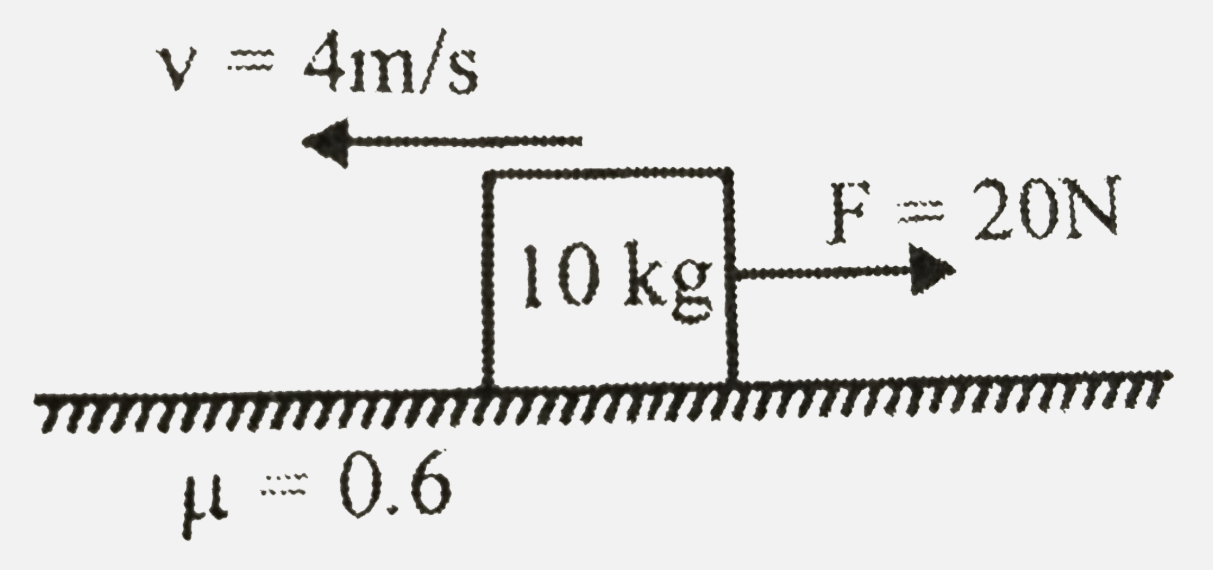A 42 kg block of ice moving on rough horizontal surface stops due to friction, after sometime. If the initial velocity of the decelerating block is , the mass of ice (in kg) that has melted due to the heat generated by the friction is (Latent heat of ice is
The correct Answer is:A
To solve the problem, we need to find the mass of ice that melts due to the heat generated by the friction when a 42 kg block of ice moving at an initial velocity of 4 m/s comes to a stop.
1. Calculate the initial kinetic energy (KE) of the block of ice:
The formula for kinetic energy is given by:
KE=12mv2
where m is the mass and v is the velocity.
Substituting the given values:
KE=12×42kg×(4m/s)2
KE=12×42×16
KE=21×16=336J
2. Relate the kinetic energy to the heat absorbed by the ice:
The heat generated by friction is absorbed by the ice and causes it to melt. The heat absorbed (Q) can be expressed in terms of the mass of ice melted (m) and the latent heat of fusion (L):
Q=m⋅L
where L is the latent heat of ice, given as 3.36×105J/kg.
3. Set the kinetic energy equal to the heat absorbed:
Since all the kinetic energy is converted into heat:
KE=m⋅L
Substituting the values we have:
336J=m⋅(3.36×105J/kg)
4. Solve for the mass of ice melted (m):
Rearranging the equation gives:
m=336J3.36×105J/kg
m=336336000=0.001kg
5. Convert the mass to grams if necessary:
m=0.001kg=1g
Thus, the mass of ice that has melted due to the heat generated by the friction is 0.001 kg or 1 gram.
The formula for kinetic energy is given by:
KE=12mv2
where m is the mass and v is the velocity.
KE=12×42kg×(4m/s)2
KE=12×42×16
KE=21×16=336J
The heat generated by friction is absorbed by the ice and causes it to melt. The heat absorbed (Q) can be expressed in terms of the mass of ice melted (m) and the latent heat of fusion (L):
Q=m⋅L
where L is the latent heat of ice, given as 3.36×105J/kg.
Since all the kinetic energy is converted into heat:
KE=m⋅L
Substituting the values we have:
336J=m⋅(3.36×105J/kg)
Rearranging the equation gives:
m=336J3.36×105J/kg
m=336336000=0.001kg
m=0.001kg=1g
Similar Questions
Knowledge Check
A 10 kg block is set moving with an initial speed of 6 m/s on a rough horizontal surface. If the force of friction is 20 N, approximately how far does the block travel before it stops?
A1.5mB6 mC3 mD9 mSTATEMENT-1: A block of mass m starts moving on a rough horizontal surface with a velocity v. It stops due to friction between the block and the surface after moving a certain distance. The surface is now tilted to an angle of 30∘ with the horizontal and the same block is made to go up on the surface with the same initial velocity v. The decrease in the mechanical energy in the second situation is smaller than that in the first situation.
because
STATEMENT-2: The coefficient of friction between the block and the surface decreases with the increase in angle of inclination.AStatement-1 is True, Statement-2 is True, Statement-2 is a correct explanation for statement-1.BStatement-1 is True, Statement-2 is True, Statement-2 is NOT a correct explanation for Statement-1.CStatement-1 is True, Statement-2 is False.DStatement-1 is False, Statement-2 is True.A block of ice of mass 50kg is sliding on a horizontal plane. It starts with speed 5ms−1 and stop 3 after moving through some distance. The mass of ice that has melted due to friction between the block and the suface is (assuming that no energy is lost nad the surface is (assuming that no energy is lost and latent heat of fustion of ice is 80 calg−1)
A2.86 gB3.86 gC0.86 gD1.86 g
A block of ice of mass M= 50 kg slides on a horizontal surface. It starts with a speed v=5.0m/s and finally stops after movng a distance s=30 m. What is the mass of ice that has melted due to friction between block and surface? Latent heat is fusion of ice is Lf=80 cal/g.
View SolutionFrom what heigh should a piece of ice fall so that it melts completely ? Only one quarter of the heat produced is absorbed by the ice. Latent heat of ice is 3.4×105jkg−1 and g=10ms2.
View SolutionA small body of mass m moving with velocity v0 on rough horizontal surface, finally stops due to friction. Find, the mean power developed by the friction force during the motion of the body, if the frictional coefficient μ=0.27,m=1 kg and v0=1.5ms−1.
View SolutionA force of 49 N just able to move a block of wood weighing 10 kg on a rough horizontal surface , then coefficient of friction is
View SolutionAsseration : A block of mass m starts moving on a rough horizontal surface with a velocity v. It stops due to friction between the block and the surface after moving through a ceratin distance. The surface is now tilted to an angle of 30∘ with the horizontal and same block is made to go up on the surface with the same initial velocity v. The decrease in the mechanical energy in the second situation is small than the first situation.
Reason : The coefficient of friction between the block and the surface decreases with the increase in the angle of inclination.
View Solution

